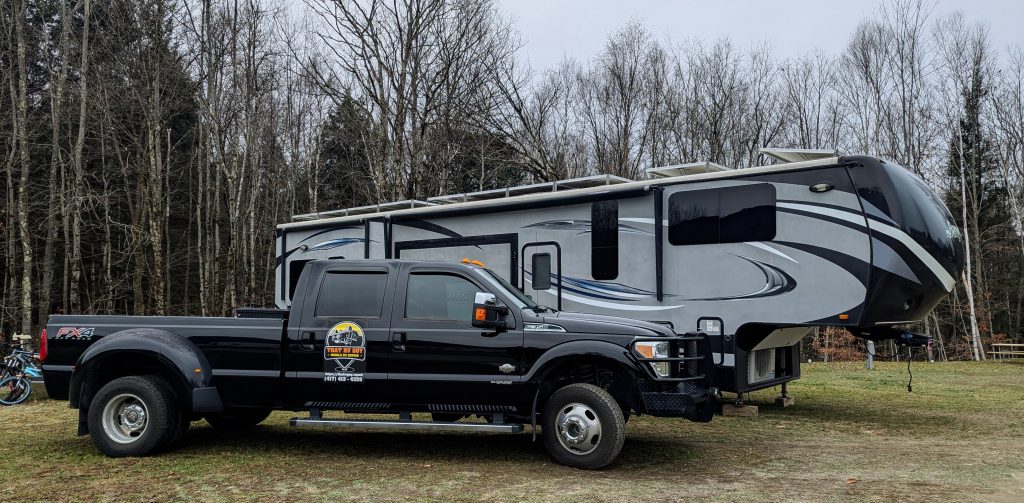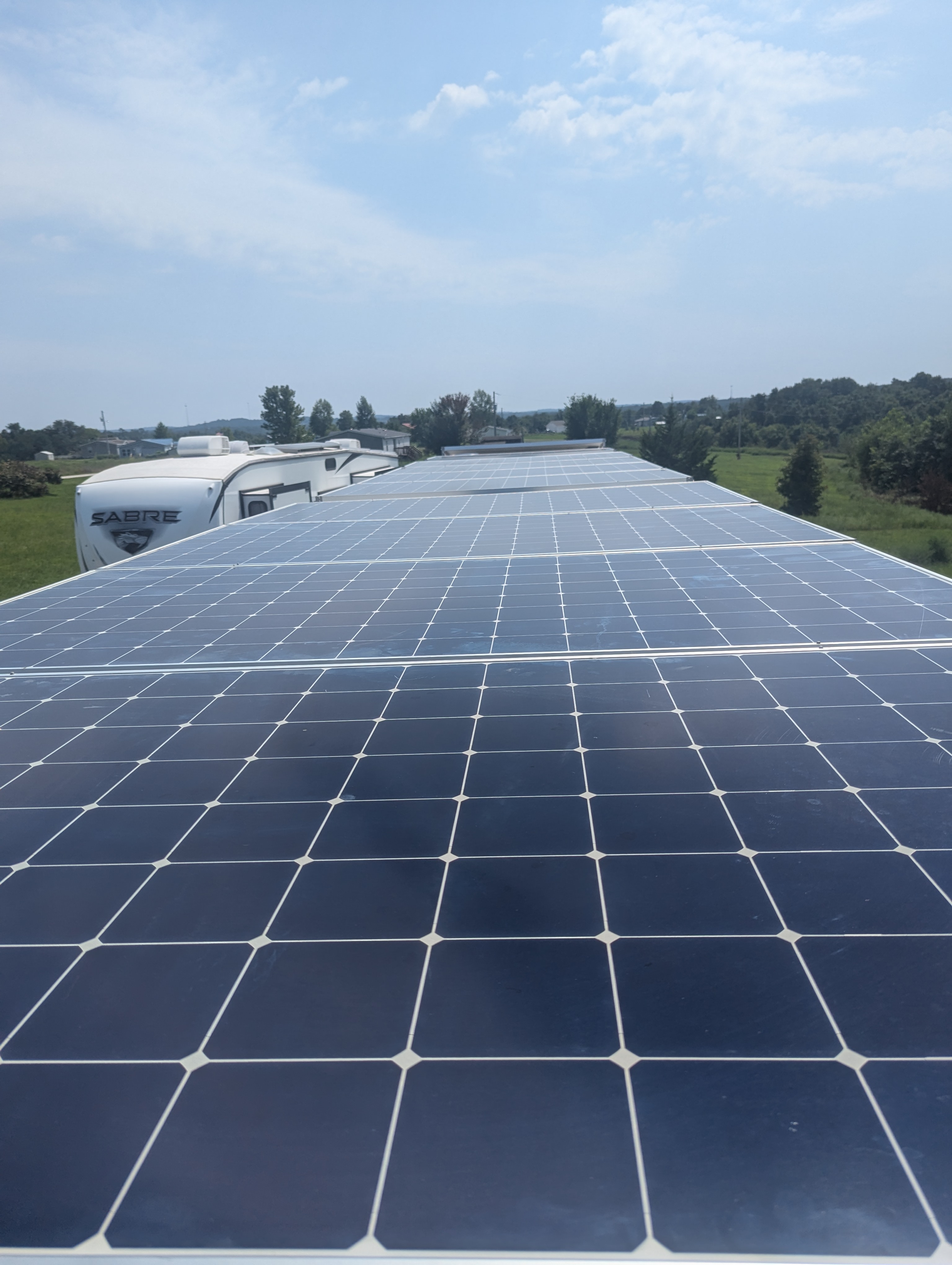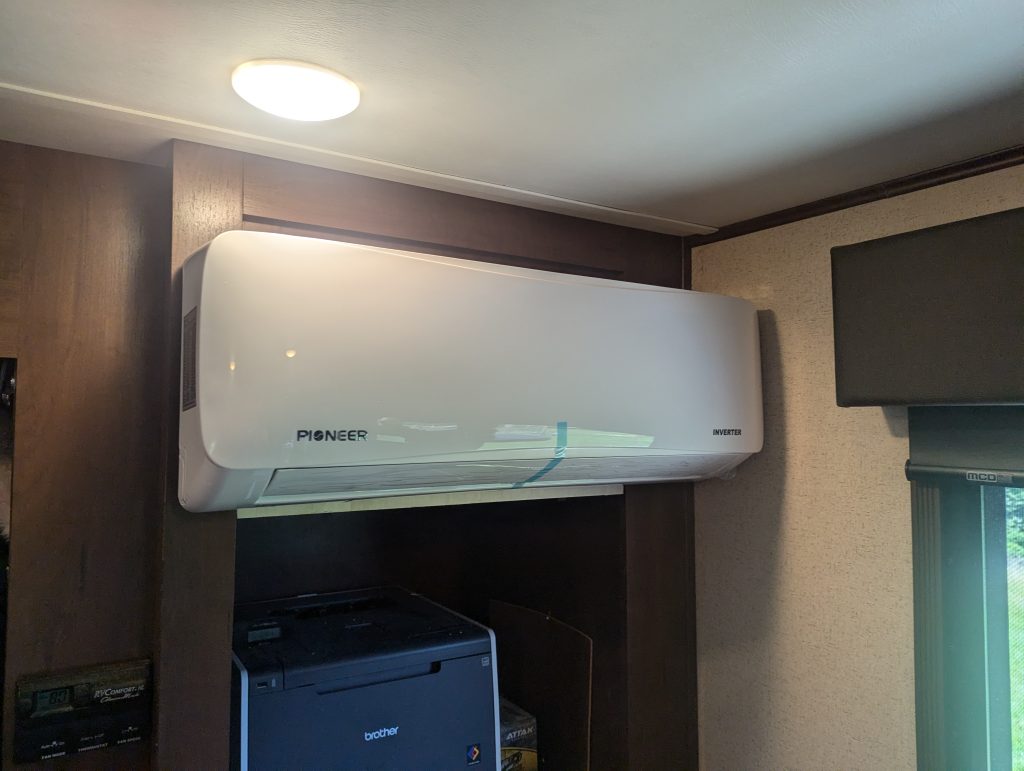
Meet “The Crow”
We get a lot of questions about our RV, so we created this page to showcase some of the upgrades we have made to the rig.
This RV was designed to boondock in comfort. We installed an solar powered inverter system that supplies power to the entire RV, as well as a power efficient three-zone minisplit HVAC system. With these upgrades this RV can camp anywhere and still provide all the comforts of a grid tied home.
Electrical System Upgrade
Inverters

Electrical power is provided by two Victron Multiplus 12/3000/120 inverters operating in a split-phase pair. The inverters supply 240V power to the three-zone mini-split, as well as to the RV’s main electrical panel.
Batteries
The battery bank in this RV consists of two 280Ah EcoWorthy batteries, and three 206Ah SOK batteries, for a total of 1178Ah (14,136Wh) of storage.
Solar

While the batteries can be charged from shore power through the Multiplus inverter/chargers, a shore power connection is not always present. To get electricity back into the batteries, 4200 watts of solar panels were installed on the roof of the RV.
Solar Charge Controllers
The array of ten 420 watt panels is wired to Victron SmartSolar 100/50 charge controllers, with one controller connected to each battery.

Cerbo GX
At the heart of the system is the Cerbo GX. This piece of equipment ties the whole system together, displays important system information and connects to Victron’s Remote Management system (VRM). VRM allows for remote configuration of the system, and also provides historical tracking data about system performance.

240V Three-Zone Mini-Split
Any RV owner knows that staying cool in an RV can be challenging when the summer temperatures arrive. The rooftop units struggle to cool the camper effectively while using a lot of electricity at about 1500W each. In a toy hauler such as this one, that can mean almost 5000W of electricity usage during the day for just the air conditioning! Many RV owners opt to install a mini-split system due to their increased efficiency and lower power requirements.
The mini-split system used in this RV is a three-zone, 23.5 SEER Pioneer Quantum system. The outdoor unit is paired to three 12,000BTU wall mounted Pioneer Quantum indoor units. This mini-split system was chosen because of Pioneer’s reputation for longevity and great customer service.
In addition to being an air conditioner, this mini-split system also has a heat pump function. This unit will provide heat down to -13F, which is colder than this RV is likely to ever see.
Outdoor Unit
The generator was removed to provide space for the outdoor unit. The batteries were also relocated.

Indoor Units
Indoor units were installed in the same rooms as the factory installed roof-top units; one in the front bedroom, one in the center section of the RV, and one in the parent’s room (formerly the garage).



Results
Cooling Capacity
The cooling capacity of this unit when compared against the factory installed roof-top units is no contest at all. The mini-split wins easily.
This system brings the RV from 90 degrees to 75 degrees in about two hours with outdoor air temperatures in the mid eighties, and the RV in direct sunlight.
Power Consumption
The reduction in power requirements by installing this system is huge. To run all three roof-top units required about 5000 watts of electricity. By contrast, to run all three zones of the mini-split at “full blast” requires about 2100 watts of electricity.
On the heating side, this system can heat the entire RV while only using slightly more electricity than a 1500W space heater.
Once the RV has reached the target temperature the system uses even less electricity to maintain the temperature. Under regular operating conditions the system typically uses less than 1200 watts; less than one roof-top air unit.
Noise Level
We were amazed by how quiet this unit is while operating. Both the outdoor unit and the indoor units are nearly silent under normal operation. Under heavy load the outdoor unit begins to emit some noise from the compressor, but it is very quiet when compared to a roof-top unit’s compressor.
The indoor units are nearly inaudible when operating. Owners used to sleeping with the roof-top unit’s fan running to muffle outside noise may find these indoor units too quiet, even in the high-fan-speed “turbo” mode.
12V Diesel Heater
In January 2024 we purchased one of the diesel heaters that have recently become popular. We went with the Silvel branded heater for no reason other than that it was on sale at the time we purchased.

While the instructions that come with the heater leave much to be desired, this little heater is actually pretty great. We have ours mounted in one of the forward bays and ducted into the center section of the RV.
As the temperature outside reaches the freezing point and below, the mini-split becomes less capable as a heater. This little diesel heater can keep the center of the RV comfortable on its own, and makes a great supplement to the mini-split on those freezing nights.
Master Bedroom Makeover
Coming soon …
Kitchen Renovation
Coming soon …
Upgrading The Garage
Coming soon …